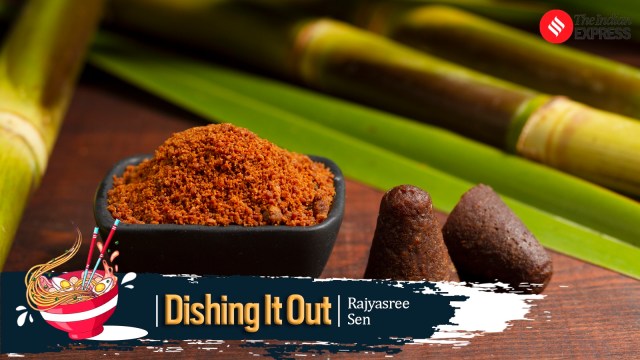📣 For more lifestyle news, click here to join our WhatsApp Channel and also follow us on Instagram
Jaggery: A sweet secret the world is finally catching onto
The origin, rich history, flavours, and cultural significance of jaggery, a sugar substitute the health-conscious crowd has woken up to.
 Jaggery is known as guda in Sanskrit and gur in Hindi. (Photo: Freepik)
Jaggery is known as guda in Sanskrit and gur in Hindi. (Photo: Freepik)The world of “healthy eating” has recently discovered the wonders of jaggery — several centuries after India did. Every “health-conscious” brand and restaurant suddenly has jaggery coffee, gur-based hot cocoa, and jaggery caramel custard on their menus. People aren’t just drawn to these dishes for their supposed health benefits — though science is yet to prove them conclusively — but because jaggery is delicious on its own and as a flavouring agent.
In Bengal, you will see small terracotta urns of liquid gold jaggery with a deep caramel flavour, called jhola or nolen gur, and solid roundels of dark brown jaggery called patali gur, pop up in sweet shops and markets in winter. Patali gur is another name for date palm jaggery. You can drizzle the liquid jaggery on luchis (puffed bread), and eat it as a snack or as the perfect end to a meal, or use it to cook gurer payesh (sweet rice pudding flavoured with gur), or use it instead of sugar to flavour your tomato chutney. The world is really your terracotta urn of jhola gur.
The many sources of jaggery
Jaggery is known as guda in Sanskrit and gur in Hindi. According to Acharya Charak, an influential figure in Ayurveda, the term guda originates from Gauda, an ancient name for Bengal, a major sugarcane-growing region. Ayurveda considers jaggery a “hot” food that becomes “colder” and less digestible as it is refined. Jaggery isn’t only derived from sugarcane. In South India, it’s made from palmyra palm juice, collected in pots smeared with lime to prevent fermentation, and then boiled until it thickens. In Bengal, wild date palm sap is set in coconut shell halves to solidify into patali gur.
The nolen gur I grew up seeing in Calcutta appears only in winter, as the date palm tree produces sap exclusively in cold temperatures, making jaggery available from November to February. The extracted sap is slowly cooked over a low flame until it becomes viscous. If stopped before crystallisation, it remains in liquid form as jhola gur, which can last six months in a sealed jar. Further reduction produces patali gur, a dark brown solid that melts in the mouth and can be preserved for over a year.
Jaggery through the ages
Jaggery has been produced since at least the 4th century BC. In Pundra Bardhan (now Bogra, Bengal), the Siuli community would climb date palm trees at night to extract sap, which was sold in markets. This trade made the region so synonymous with jaggery that Pundra Bardhan became known as Gour (gur). Jaggery also holds religious significance—Bengali sweet shops traditionally offer the first batch of nolen gur mishti or sandesh to Goddess Kali.
India produces over 70 per cent of the world’s jaggery, but it cannot claim sole credit for its popularity. Much of this comes from sugarcane jaggery, a crop introduced to the Indian subcontinent around 6000 BC via the Malayan Peninsula and Burma. Jaggery is one of the main flavouring agents in many curries and salads from these countries. And jaggery made from sugarcane and called gud is highly popular in Pakistan. In some parts of Pakistan, the jaggery is created from the Palmyrah palm, coconut palm, or date palm, and the thickened liquid is sold in moulds.
Jaggery in global cuisine
If we drizzle jhola gur on luchis, across the border, in Pakistan’s Punjab region, they prepare jaggery rice with coconut and almonds. In the colder parts of Pakistan, jaggery chai is so common that it is almost impossible to find chai with normal sugar.
In South Asia, you can find panela in Colombia and much of the Caribbean. Jaggery is called kokuto in Japan and rapadura in Brazil, and many Thai, Malaysian, and Burmese dishes use crumbled jaggery as a sweetening agent.
I would strongly recommend you to trot over to your locality’s Bengali sweet shop and taste some jaggery rosogolla or gurer sandesh or gurer payesh. The distinctive caramel taste is something refined sugar simply cannot replicate.
Next week, I’ll be writing on the chai I discovered while studying in Bombay –– cutting chai!
📣 For more lifestyle news, click here to join our WhatsApp Channel and also follow us on Instagram






- 01
- 02
- 03
- 04
- 05






















